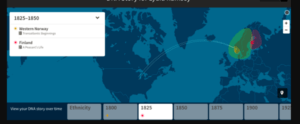Ancestry.com

Ancestry.com is combining cutting edge DNA testing with Family Trees to create and unlock value.
Currently the largest for-profit genealogy company in the world, Ancestry.com traces its family tree back to 1983. Founded as Ancestry Inc., the company has evolved with technology from publishing in magazines to floppy disks, to the internet in 1996. Millions have used the site to search for lost relatives or trace their family roots. With the advent of DNA sequencing, a new wave of technological innovations has occurred. One such transformation is using DNA to trace heritage and ethnicity. Consumers can answer questions as to what region of South America their family came from or what percent of a certain ethnicity they are.
Value Creation and Capture
Consumers provide Ancestry with a DNA sample via a home kit. Ancestry then utilizes advanced autosomal testing to analyze the provided DNA sample to sequence it. They are then able to compare the sample to their database of millions of other users’ DNA samples. Currently, Ancestry.com has a database with over 7 million DNA samples. A key differentiator and competitive advantage of Ancestry.com is that they are also able to cross this DNA information with their family tree database of over 20 billion historical family records. This allows users to connect with living relatives who would have otherwise remained unknown. As this database grows, so too does the accuracy and relevancy of the specific information that Ancestry.com is able to provide to each individual. Currently the company is able to provide information on ethnicity across 350 regions as in the example below.
The value capture is relatively straight forward. Ancestry.com charges a one-time fee of $99. If the user would like to link the data with the online family tree database, they will need to purchase a monthly subscription $19.99 for US access and $44.99 for all access. There are other revenue opportunities such as professional genealogy assistance for an additional fee. None of the other competitors are able to offer the breadth and depth of genealogical data and analysis that Ancestry.com can.
Challenges Past and Present
A significant challenge for the company comes from competitors like 23andme and LivingDNA, and MyHeritage. 23andme, for example, offers health reports to screen for genetic dispositions to certain diseases or personal characteristics. They currently offer over 70 different health reports and that number is increasing rapidly. Ancestry.com should focus on its core competency of genealogical analysis to maintain and grow its market share. As its database grows, Ancestry.com gains a strategic advantage that others will have a very hard time emulating.
Another challenge comes in the form of legal battles. Recently, Ancestry.com reports were used as the basis of a law suit claiming medical malpractice. While not the defendant per se, Ancetry.com will likely have to defend the accuracy and validity of their results which could significantly increase their legal liability. Privacy of data is a final challenge facing the company. While they have taken many steps to assure users that Ancestry.com only licenses the DNA data from the consumer, they do store the information indefinitely unless the user requests otherwise. In spite of these challenges, the future is bright for Ancestry.com.
Sources:
http://www.businessinsider.com/best-dna-test-23andme-ancestry-national-geographic-2017-4
https://www.ancestry.com/dna/
https://www.ancestry.com/corporate/newsroom/press-releases/ancestry-surpasses-5-million-people-dna-database-giving-customers-even-more
Vandre, Megan (June 4, 2001). “Roots: A hobby you never finish (page 1 title: Internet has millions tracing their roots)”. Section 4: Business Tech. Daily Herald. Medill News Service. p. 3. Accessed April 09, 2018
Regalado, Antonio (2018-02-12). “2017 was the year consumer DNA testing blew up”. MIT Technology Review. Accessed April 09 2018
https://www.cnn.com/2018/04/04/health/fertility-doctor-dna-test-lawsuit-bn/index.html






Thanks for this super interesting post, Curtis. While I agree that ancestry.com has a powerful database, do you think they are doing enough analytics on it to create value? The real value of genetic information comes from how that information is used to predict future possibilities, as 23andMe does by evaluating disease predisposition (as you have so insightfully pointed out as well). In such an environment, ancestry.com’s value proposition seems a bit weak, doesn’t it? As a user, I would prefer to know more about what diseases I could be predisposed to and how I can prevent them, as opposed to which region of the world were my ancestors from or what my ethnicity comprises of. That could just be my preference, but I imagine it would resonate with many people from our generation. Ancestry.com has a real asset in the form its database, but it needs to find creative ways to leverage it, otherwise it may find itself being overtaken by its competitors.